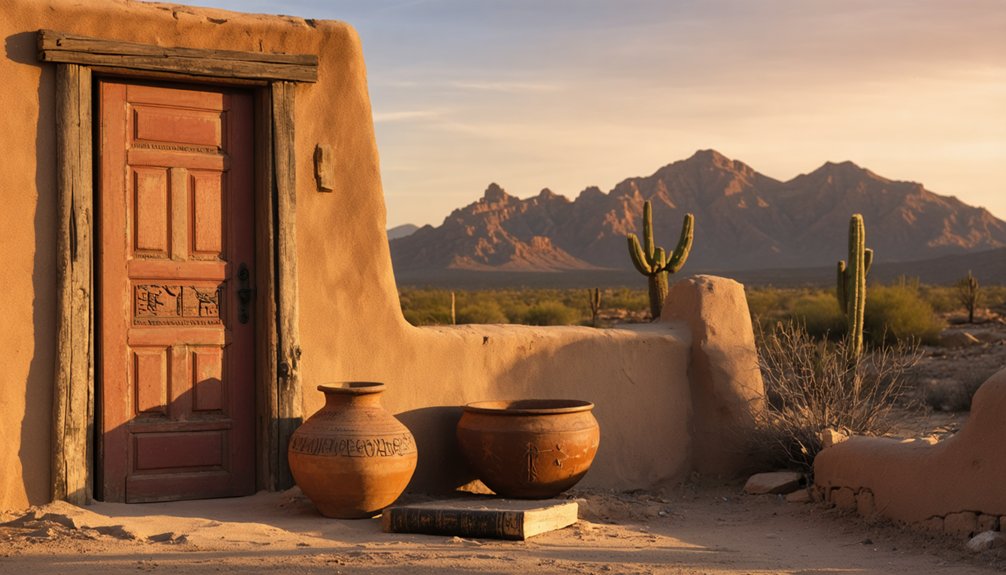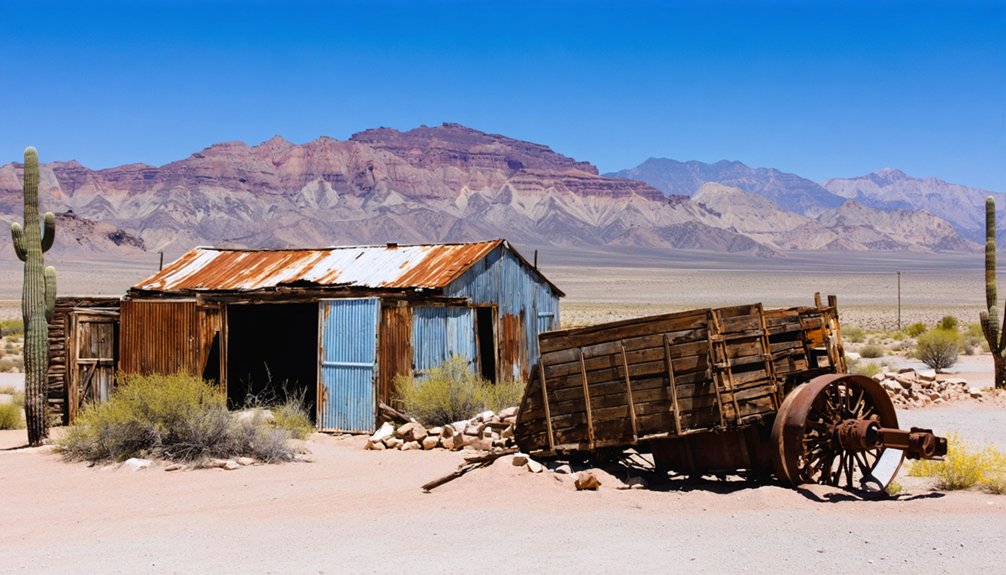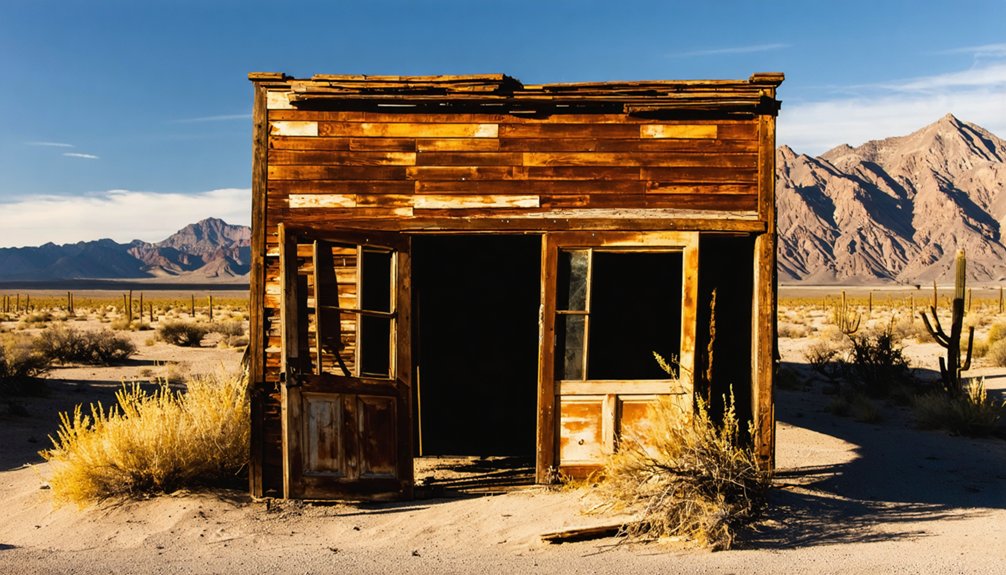Kofa, named from “King of Arizona,” emerged when Colonel Eugene Ives discovered gold in 1896. You’ll find this ghost town grew to 750 residents at its peak between 1896-1910, with mining operations producing about one ounce of gold per ton. Water scarcity ultimately challenged miners who faced 108°F summers and relied on 1,000-foot wells. The diverse workforce created a multicultural frontier before economic factors turned boom to bust. The silent mountains still guard these stories.
Key Takeaways
- Kofa was a gold mining town named after “King of Arizona” mine, established in 1896 by Colonel Eugene Ives.
- At its peak from 1896-1910, Kofa’s population reached about 750 residents before declining as gold reserves depleted.
- Water scarcity plagued the mining operations, requiring wells over 1,000 feet deep and contributing to the town’s eventual abandonment.
- The multicultural workforce included Mexican and Cornish miners who adapted to extreme desert conditions through innovative building techniques.
- Today, Kofa is a ghost town within the Kofa National Wildlife Refuge, established in 1939 to protect desert bighorn sheep.
The Birth of “King of Arizona”: How Kofa Got Its Name
While most ghost towns in Arizona’s rugged landscape bear names with straightforward origins, Kofa’s designation stems from a clever acronym that Colonel Eugene Ives created in the late 1890s. After discovering gold in 1896, Colonel Ives purchased property and established the “King of Arizona” mine, taking the first letters to form its distinctive name.
The gold mine operated from 1896 to 1910, transforming the surrounding area. When the town received its official post office in 1900, with Lewis W. Alexander as its first postmaster, the KOFA name was firmly established.
This acronym’s historical significance extended beyond the town itself, eventually giving its name to the Kofa Mountains, where Signal Peak rises 4,877 feet, and later to the 665,000-acre wildlife refuge established in 1939. Today, Signal Peak remains an iconic landmark and serves as the highest point in Yuma County, attracting hikers who approach via the rough Queen Mine Road. The refuge was originally created after Arizona Boy Scouts advocated for conservation measures when they observed a decline in the desert bighorn sheep population in 1936.
Gold Rush Fever: Mining Operations That Built a Town
You’d scarcely believe the fever that gripped Kofa’s miners when ore samples yielded a stunning $2,000 per ton in gold and silver, transforming a barren stretch of desert into a bustling mining settlement of 300 residents.
The initial placer mining operations quickly shifted to hard rock extraction once the easily accessible alluvial gold (worth roughly $40,000) had been retrieved, necessitating the construction of mills—first 50 miles away at Mohawk due to water scarcity, then later on-site after wells struck water in 1899.
The King of Arizona mine‘s continuous operation from 1897 through summer 1910 relied on a diverse workforce who expertly processed the fine-grained free gold from a mineralization containing galena in gangue of coarse fluorspar and calcite crystals. The mine featured a main shaft extending 700 feet deep with approximately 2,000 feet of drifts. The town’s population reached its peak of around 750 residents during the height of mining operations before declining as ore quality diminished.
Striking Gold, Striking Rich
In 1896, the quiet expanse of the Kofa Mountains erupted with excitement when Charles E. Eichelberger struck a gold-bearing vein. News spread like wildfire, and by April 1897, you’d find about 100 settlers staking their claims in this harsh desert landscape.
Early prospectors initially focused on placer gold, extracting an impressive $40,000 from deposits downslope of the main vein. But the real prize was the lode mine, which would later become the legendary King of Arizona (Kofa) mine.
Gold mining transformed this barren stretch of wilderness into a bustling hub of economic activity. Despite water scarcity forcing miners to haul this precious resource by mule over great distances, the promise of striking it rich kept them persevering until wells finally struck water in 1899, five miles from the mine. The Big Eye Mining Company produced gold at approximately 1 ounce per ton while also extracting smaller amounts of silver, copper, and lead.
Mill Operations and Capacity
The remarkable transformation of the King of Arizona mine began in 1899 when wells finally struck water at approximately 1,000 feet depth, five miles from the mining site.
This critical water supply, piped directly to the mine, enabled the construction of a substantial processing facility that would become the heart of Kofa’s operations. The nearby North Star Mine, which was sold to Golden Star Mining Company in 1907, contributed significantly to the area’s gold production.
Multicultural Mining Workforce
While the King of Arizona mine flourished with its newfound water supply and processing capabilities, Kofa’s transformation into a thriving mining town hinged equally on the diverse workforce that powered its operations.
Mexican workers began arriving in mid-1902, dramatically expanding Kofa’s labor force amid growing production demands. You’d have witnessed stark cultural integration challenges as the town developed a hierarchical structure with skilled Cornish miners (“Cousin Jacks”) occupying privileged positions while Mexican laborers faced systematic disadvantages. Despite these challenges, Mexican miners developed labor solidarity networks that would later influence unionization efforts across Arizona mining districts.
The labor dynamics included discriminatory two-tiered wage systems, segregated housing, and disproportionate exposure to workplace hazards. The company imposed a copper collar environment where management maintained strict control over working conditions and suppressed organizing efforts.
As families joined the isolated community, social dynamics evolved, though company control remained pervasive. During World War One, non-citizen workers faced additional challenges including military induction pressure, blacklisting for union activities, and deportation threats—creating an environment where freedom was constantly contested.
Life in the Desert: Surviving Harsh Conditions
You’d find Kofa miners battling daily temperature fluctuations of 26 degrees, with scorching July temperatures averaging 108°F by day before dropping to more manageable 82°F at night.
Your survival in this harsh environment would depend on clever water conservation techniques, as the region received merely 0.49 inches of precipitation in July and a scant 0.16 inches in August. Spring months provided little relief from the water scarcity, with only 0.08 inches of rainfall in April.
Innovative desert adaptations became essential, from building thick-walled adobe structures that maintained cooler interior temperatures to developing sophisticated water collection systems that captured even the minimal condensation formed during the cool desert nights. The miners had to adapt like the specialized vegetation of hot desert ecosystems, which evolved unique features to survive with minimal water resources.
Extreme Heat Adaptations
Surviving in a region where summer temperatures routinely exceed 100°F (38°C) requires extraordinary biological mechanisms, which Kofa’s desert inhabitants have perfected over millennia.
You’ll notice the desert’s creatures have mastered heat survival through strategic timing—becoming active during cooler nights while seeking shelter in burrows and rock crevices during scorching days.
Their desert adaptations are marvels of evolution: light-colored coats reflect sunlight, while large ears serve as natural radiators.
Desert mammals possess specialized kidneys that concentrate urine, conserving precious moisture.
Plants aren’t left behind—cacti replace water-wasting leaves with spines and develop thick, waxy coatings to minimize evaporation.
These organisms also produce protective proteins that repair cellular damage from thermal stress, allowing them to thrive where others couldn’t survive a day.
Water Scarcity Solutions
Despite harsh desert conditions, residents of Kofa and surrounding Arizona communities have developed sophisticated water management strategies to combat extreme scarcity.
You’ll find innovative solutions like Managed Aquifer Recharge (MAR) projects, where unused Colorado River water is stored underground, raising water tables at remarkable rates. These projects protect precious water from evaporation while creating reserves for drought periods.
Local water conservation efforts have evolved beyond simple restrictions. Communities now implement extensive systems including rainwater harvesting, greywater recycling, and brackish water treatment for landscaping.
Rural households, once dependent on unreliable wells or expensive hauled water, can now participate in community water improvement districts to secure alternative sources.
Arizona’s Water Infrastructure Finance Authority supports these initiatives through grants and loans, prioritizing long-term reliability while recognizing that each drop saved is as valuable as each drop found.
Desert Dwelling Innovations
Living in the harsh Kofa desert requires ingenious shelter solutions that have evolved through generations of adaptation and necessity.
You’ll find desert architecture here centered around temperature regulation rather than permanence.
When building your sanctuary, dig a scout pit 1.5 feet deep, using excavated sand to create three-sided windbreaks. Position your shelter behind natural dunes or rock formations for added protection. Layer your materials strategically—dual-layer tarps create insulating air gaps that greatly reduce internal temperatures.
For longer stays, wickiup structures offer more substantial protection. Collect saplings to form dome-shaped frameworks, securing them at ground level while tying them at the top. Line your dwelling floor with extra clothing to prevent heat absorption from the ground.
These simple techniques transform hostile environments into livable spaces using minimal shelter materials from the surrounding landscape.
Water Wars: The Critical Resource That Determined Kofa’s Fate
In the unforgiving desert landscape of Kofa, water wasn’t merely a precious resource—it was the lifeblood that ultimately determined the mining town’s fate.
Mining operations depended on wells drilled over 1,000 feet deep, located miles from the actual worksite. Arizona’s prior appropriation doctrine—”first in time, first in right”—created fierce water rights competition. Early mining efforts predated major water infrastructure projects, leaving Kofa perpetually thirsty while mining conflicts erupted between competing interests.
While the Roosevelt Dam and Salt River Project supplied growing urban centers in the early 1900s, Kofa remained isolated from these lifelines. The exorbitant cost of transporting water to this remote location ultimately made operations unsustainable.
Without connection to later developments like the Central Arizona Project, Kofa’s thirst was never quenched, sealing its abandonment.
Multicultural Frontier: The People Who Called Kofa Home

While Arizona’s harsh desert conditions presented extreme challenges for settlement, Kofa attracted a remarkably diverse population that transformed this mining outpost into a multicultural frontier community.
After 1900, the town swelled to 750 residents, with Cornish miners and their families forming the backbone of this growing society.
Cornish Heritage dominated the landscape as these skilled workers brought centuries of hard rock mining expertise.
Family Networks facilitated chain migration, creating distinct ethnic enclaves throughout the town’s 100 structures.
Unlike transient mining camps, Kofa developed genuine community institutions—a school established in 1900 served growing families, while four saloons provided social spaces where cultural boundaries blurred.
This combination of specialized mining knowledge and diverse cultural traditions created a unique frontier society where innovation and adaptation became essential survival skills.
From Boom to Bust: The Decline of a Mining Empire
The euphoric gold rush that birthed Kofa’s mining empire began with extraordinary promise when the King of Arizona mine opened in 1907, following its discovery just one year earlier.
Early success was stunning—a test lot of surface ore yielded nearly $10,000 in precious metals.
A mere test yielded riches that beckoned thousands to Kofa’s golden promise.
Mining technology advanced quickly with a 50-ton cyanide and crushing plant expanding to 100-ton capacity. At its peak, the operation processed 200 tons of $40-per-ton ore daily. Nearby, the North Star mine employed nearly 350 workers.
But by 1910, economic factors turned against Kofa’s fortune. As miners dug deeper, ore quality deteriorated dramatically. Treatment costs outweighed profits, making continued operations financially impossible.
The King of Arizona closed in August 1910, with North Star following in 1911. The once-thriving community rapidly transformed into the ghost town you’ll find today.

Today’s visitors to Kofa enter a landscape where nature has reclaimed what miners abandoned over a century ago. The ghost town sits at 1,700 feet elevation within the vast 666,641-acre Kofa National Wildlife Refuge, established in 1939.
You’ll need to navigate carefully, as most roads remain unmaintained across this Sonoran desert habitat. When exploring historical mining sites, remember that collection of artifacts, plants, or animals is strictly prohibited. Firearms and explosives (including fireworks) are regulated, and geocaching isn’t permitted.
Prepare thoroughly for primitive conditions—bring water, sun protection, and your own firewood. The refuge rewards your efforts with exceptional stargazing, desert bighorn sheep viewing, and photography opportunities throughout the historical exploration.
Contact the refuge office (928-928-6873) before your journey to check current conditions.
Frequently Asked Questions
Were There Any Famous Outlaws or Crimes in Kofa’s History?
You’ll find Kofa’s crime history includes Joaquin Nogales, who attempted arson and received six years, and “Pinky Dean,” who slashed a miner. These outlaw legends emerged amid the town’s violent, whiskey-soaked atmosphere.
What Happened to Kofa’s Residents After the Mine Closed?
They scattered, they relocated, they sought new beginnings. You’ll find Kofa’s legacy in the mass exodus of miners who abandoned their homes, seeking employment elsewhere when economic reality forced their difficult departure.
Did Any Natural Disasters Affect Kofa During Its Existence?
You won’t find records of flood impact or earthquake history affecting Kofa. The harsh desert climate and water scarcity challenged residents, but no catastrophic natural disasters struck during the town’s existence.
Are There Any Documented Ghost Stories or Paranormal Activity?
You won’t find documented ghost sightings at Castle Dome. Unlike Arizona’s famous haunted locations like Jerome or Tombstone, this mining settlement hasn’t established a reputation for paranormal activity in historical records.
What Archaeological Artifacts Have Been Recovered From Kofa?
You’ll discover mining artifacts of archaeological significance at Castle Dome Mining Museum, including vintage Levi Strauss pants, hand tools, Spanish headstones, silver ore specimens, and household items from roughly 300 abandoned mines.
References
- https://westernmininghistory.com/towns/arizona/kofa/
- https://www.apcrp.org/KOFA/KOFA_CEM._MASTdoc.htm
- https://www.ghosttowns.com/states/az/kofa.html
- https://en.wikipedia.org/wiki/Kofa
- https://azoffroad.net/castle-dome-city
- https://wheninyourstate.com/arizona/kofa-national-wildlife-refuge/
- https://www.spl.usace.army.mil/Missions/Formerly-Used-Defense-Sites/Kofa-National-Wildlife-Refuge/
- https://www.youtube.com/watch?v=uf65F8hx9xs
- https://kids.kiddle.co/Kofa
- https://rscottjones.com/a-day-spent-exploring-the-kofa/



